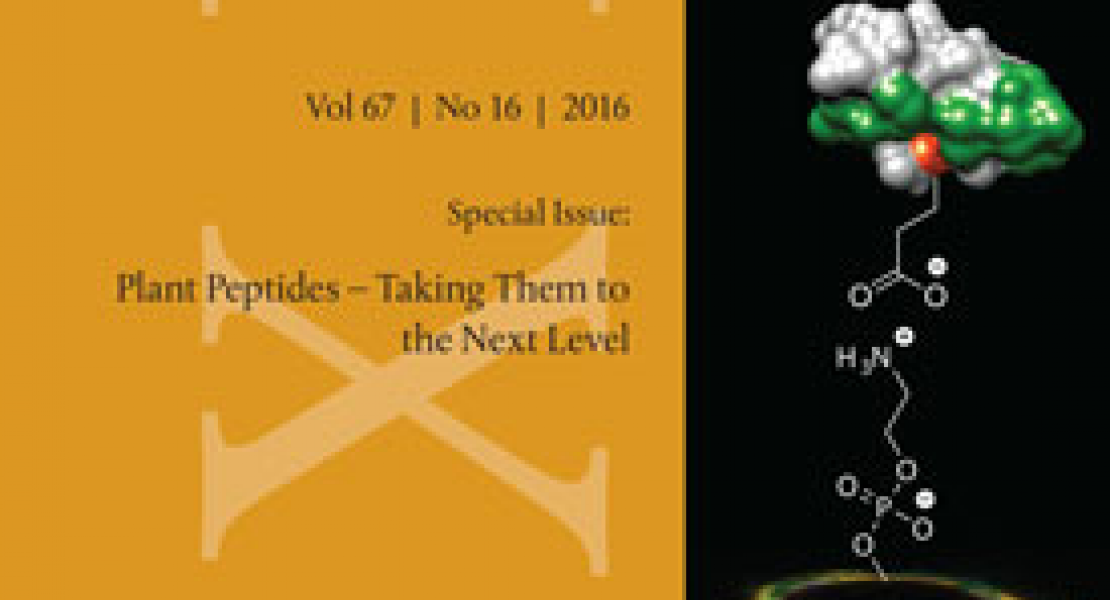In a Special Issue of Journal of Experimental Botany, edited by Barbara De Coninck (VIB-KU Leuven) and Ive De Smet (VIB-UGent), plant peptides take central stage. The issue bundles recent knowledge on small signalling plant peptides and is published this month. Several contributions involving VIB scientists are included.
Although peptides are for a long time studied as signal molecules in animals, still little is known about peptides in plants. Plant scientists are only recently exploring the wealth of peptides that plants can produce. New insights are accumulating and tell us that small signalling peptides not only play a role in all plant growth and developmental processes, but also function as key regulators when plants perceive stress.
In a Special Issue of JXB, recent research papers and reviews on peptides in plants were compiled. The various research articles combine genetic, biochemical and developmental studies to gain insight in peptide function and mode of action. This increasing knowledge on plant peptides opens the door to a new set of candidate proteins that can be used to monitor and regulate plant growth and stress responses. Moreover, these peptides, and their receptors, are often functionally conserved, making it straightforward to translate this knowledge to crops.
A team of scientists led by Ive De Smet (VIB-UGent) reports on a new, and likely local, role of the CEP5 peptide in lateral root initiation and the fact that this peptide potentially acts as a negative regulator of its receptor3. In a second paper, De Smet and several international colleagues pinpoint a new role to a member of another peptide family, namely RALFL34, in controlling positioning and development of lateral roots.4 The potential involvement of this peptide in lateral root initiation became apparent through transcript profiling and was supported through detailed phenotypical analyses of mutants. Furthermore, a study supervised by Pierre Hilson (VIB-UGent/INRA) and several PSB colleagues, investigated the signalling activity of the GOLVEN1 peptide in the control of plant organ growth.2
Barbara De Coninck (VIB-UGent) says: “Few plant peptides have been characterized in detail so far and these are only the tip of the iceberg. We estimate that plants make more than 1000 functional peptides – and likely much more – and all of these hold potential for future studies.”
References to the full articles
1.Czyzewicz, Nathan; Nikonorova, Natalia; Meyer, Matthew R; Sandal, Priyanka; Shah, Shweta; Vu, Lam Dai; Gevaert, Kris; Rao, A. Gururaj; De Smet, Ive. (2016). The growing story of (ARABIDOPSIS) CRINKLY 4.
2 Ghorbani, Sarieh; Hoogewijs, Kurt; Pečenková, Tamara; Fernandez, Ana; Inzé, Annelies; Eeckhout, Dominique; Kawa, Dorota; De Jaeger, Geert; Beeckman, Tom; Madder, Annemieke; Van Breusegem, Frank; Hilson, Pierre. (2016). The SBT6.1 subtilase processes the GOLVEN1 peptide controlling cell elongation.
3 Roberts, Ianto; Smith, Stephanie; Stes, Elisabeth; De Rybel, Bert; Staes, An; van de Cotte, Brigitte; Njo, Maria Fransiska; Dedeyne, Lise; De Mol, Hans; Lavenus, Julien; Audenaert, Dominique; Gevaert, Kris; Beeckman, Tom; De Smet, Ive. (2016). CEP5 and XIP1/CEPR1 regulate lateral root initiation in Arabidopsis.
4 Murphy, Evan; Vu, Lam Dai; Lin, Zhefeng; Van den Broeck, Lisa; Ramakrishna, Priya; van de Cotte, Brigitte; Gaudinier, Allison; Brady, Siobhan; Slane, Daniel; Beeckman, Tom; Goh, Tatsuaki; Inze, Dirk; Fukaki, Hidehiro; De Smet, Ive. (2016). RALFL34 regulates formative cell divisions in Arabidopsis pericycle during lateral root initiation.
- Log in to post comments
